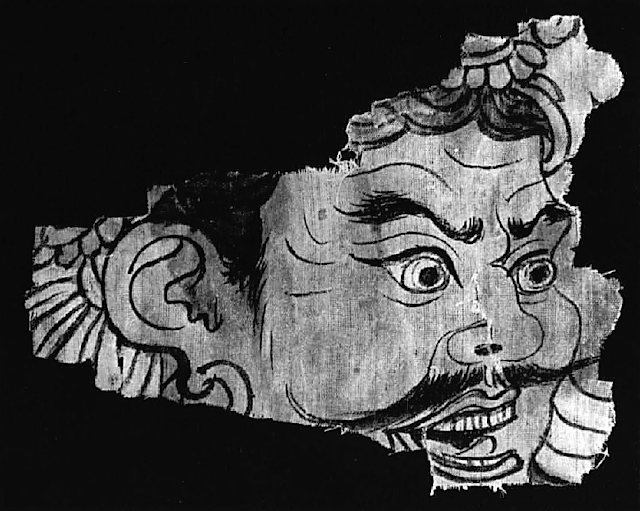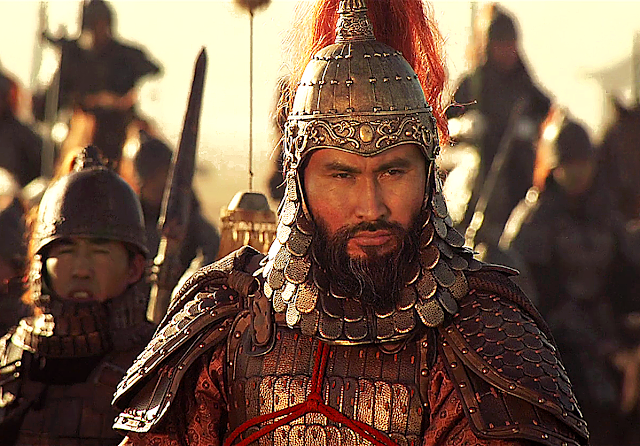Tang Dynasty Cavalry Overview 大唐骑兵
The Tang empire in 669 AD after the vassalization of the Eastern Gokurks and the complete defeat of the Western Gokturks. The Tang would incorporate the various vassals of the Western Turks, accepting tributes from the polities all along the coast of the Aral Sea.
Closeup of of a military parade from the Dunhuang Grottoes which displayed the Tang heavy cavalry in full combat gear, supplanted by heralds and ensigns (probably Central Asian auxiliaries) in silk uniforms. The heaviest elements of the cavalry are encased in lamellar armors. These represents the medium elements of Tang cavalry~ the heaviest elements, i.e. the ones used by the generals and the imperial guards would not only have a rider in full lamellar armor but would also ride on horses completely covered in lamellar or scale armor as well.
A Tang dynasty heavy cavalryman. The soldier is almost entirely encased in heavy lamellar armor, and carries a distinctive painted lacquer shield with kite- like 4 color motif. In his right hand he carries a battle axe and a composite bow is slung by his side.
STAFFING
A Tang generalissimo in heavy Mingguang armor. Tang armies were initially led by a military aristocracy, but by the end of the dynasty most of the Tang generals were appointed military governors (Jiedushi) that virtually governed their frontiers like their own private kingdoms.
As such, Taizong regularly recruited and promoted military officers of Turkic ancestry, whose steppe experience contributed to the western and northern expansion of the Tang empire. The Turkic generals Ashina She'er, Ashina Simo, Ashina Helu (all of the royal Ashina clan of the Gokturks) participated in the Tang capture of the Karakhoja, Karasahr, and Kucha kingdoms in Xinjiang for the dynasty.
ARMOR
Most of the Tang cavalry wore very heavy lamellar armor that covered their bodies, consisted of small platelets known as "lamellae", which are punched and laced together, typically in horizontal rows.
HORSE ARMOR
Chanfron and barding (horse armor) of a 4th-7th century Chinese cataphract,
note the ostentatious plume Jisheng 寄生, lit. "parasite" on the horse's hip.
With the invention of the of the solid saddle allowed development of the true stirrup as it is known today. The higher stability provided to the rider augmented the already powerful armored horsemen into true (one could almost say) medieval cavalry.
By the Tang Dynasty, the empire fielded a massive core of heavy cavalry that fought with great contingents of steppe auxiliary from client protectorates. The endless wars with the various Turkic polities would see them extensively deployed against China's foes on its northern and western fringes.
COMBAT HISTORY (THE TANG GOKTURK WARS)
The military of the empire was based on the Fubing system, a draft system where quotas of local militias could be mobilized quickly in times of war. By the year 737, Emperor Xuanzong of the Tang discarded the policy of conscripting soldiers that were replaced every three years, replacing them with long-service soldiers who were more battle-hardened and efficient.
Top: Tang cataphracts, with soldiers in mingguang armor and horses encased in barding.

7th-8th century 突厥汗国 Gokturk champions in lamellar armor- intersected by a kneeling horse archer. The main fighting strength of the Gokturks lies within their extremely mobile cavalry archers
回鶻 Uighurs allies of the Tang~ originally from Mongolia who were positioned to be in charge of much of the Tarm Basin in the 8th-9th century~ during which they served as Tang military vassals in the region.
The nature of the army was heavily influenced by the sort of fighting that it engaged in. For most of the Tang dynasty the wars were fought against the mobile, nomadic tribes of Inner Asia. As a result the Tang largely abandoned heavy cavalry in favor of the more nimble and versatile light cavalry (qingji) and battles frequently relied on feints by small forces to lure the enemy into traps (eg. Irtysh in 657). Though heavy cavalry~those with lamellar barding and other heavy horse armor were still provided for the generals and the guard troops.
Indeed the use of cavalry is one of the most notable aspects of the Tang Dynasty and considerable effort was invested in breeding and training horses, the result of this was that the Tang Dynasty was able to field a larger cavalry element than ever before. ~It should be also noted that at a large portion of many of such distinguished "Tang" cavalry divisions are themselves composed of Turks auxiliary and led by Turkic commanders.
THE TANG GOKTURK WARS
The massive Gokturk Empire (552-659). a virtual "super power" of the region. A multi ethnic empire that predated the Mongol Empire by over 600 years. During the nearly three century of
political fragmentation in China known as the Era of Disunity~ or the Northern and Southern
Period. The Gokturks took advantage of the chaos in China and played off the various Chinese polities against each other.
However, when a unified China was reformed under the Sui dynasty, Emperor Wen of Sui reverted this by playing off the various brothers and uncles of the Gokturk Khagan (Khan,) who ruled as lords and frontier generals- against him by exorbitant bribes. The short-lived Sui would collapse 30 years later, displaced by the new Tang dynasty~ By the beginning of the Tang dynasty, the mighty Gokturk empire has already shown disturbing signs of fragmentation- and had split into two empires~ the Eastern and the Western Gokturk Empire following a Civil War.
The Northern and Southern Dynasties of a divided China: The north was simultaneously divided between the mighty Northern Zhou in the NW (from where the Sui would one day rise up) and the Northern Qi- in the NE. During the 50 years since the Gokturk Empire's founding, they would have at times married with the Princesses of one of the northern Chinese polities while simultaneously raided the other. For those who lived in northern China, Gokturk raids were a constant affair, if not in the east then in the west.
CONFLICATIONS

Early military conflicts were a result of the Tang interventions in the rivalry between the Western and Eastern Turks in order to weaken both. Under Emperor Taizong, campaigns were dispatched against the Turkic affiliated cities of the Tarim Basin, against Karakhoja in 640, Karasahr in 644 and 648, and Kucha in 648. A campaign that nearly mirrored those conducted by Emperor Wu of the Han against the Xiongnu 600 years ago.
Elite Tang dynasty cavalryman wearing the distinctive 虎冠 "tiger crown" that marked them as some of the most elite warriors on the battlefield, sometimes the item would be sewn out of colorful fabrics with gilded rims and lacquered features that imitated a grimacing tiger while other times real tiger skin (claws and head) would be used to give the wearer a ferocious aspect. These wings usually gathered the bravest and the highest quality of fighting troops
The Tang empire in 669 AD after the vassalization of the Eastern Gokurks and the complete defeat of the Western Gokturks. The Tang would incorporate the various vassals of the Western Turks, accepting tributes from the polities all along the coast of the Aral Sea.
With the great sand sea of the Taklamakan desert at its center, and the ring of shield- like mountains surrounding it on four sides, human settlements could only emerge from the sparse oases dotting the region. With time, each of these oasis erected its own walled city-state headed by a local king.

TANG DECLINE, ASCENSION OF THE UYGHURS
Mural painting of a smiling Uyghur prince. Another relief depits a camel trader
The Uighurs, a Turkic ally of the Tang dynasty that aided the destruction of the Gokturks-
during the 8th-10th century still preserved their Buddhist- Manichaean beliefs, were rotated
into a position of power as a result of these wars. ^ The above painting depicts high Uighur princes in elaborate colorful garbs. The Migration of the Turkic people would bring Islamic
Jihad ricochet back into the Tarim Basin and instill Islam as the dominate religion
in the region with the utter displacement of Buddhism.
Central Asian mural depicting Buddhist monks, during this era, the Buddhist and Manichean religions factions held great sway over the Uyghur people.
A scroll written with the ancient Khotanese, a Saka (Indo- European) language
Central Asia absorbed much cultural influences from the conflict. Ironically, because the Turk's ancestors have actually originated from Modern Mongolia and had mostly operated there in the centuries before the conflict~ with the deployment of such vast Turkic communities as military garrisons and colonizers, this conflict actually began a billiard- ball effect of sending out Turkic Migrations that ultimately spilled the Turks into the Middle East.
Through the breach of this natural membrane, which had formerly contained the Turks within the northern steppes, Turkic culture and language spread further into the deserts of Central Asia and would one day be exposed to the influence of Islam that would cause a genocidal civil war between rival Turkic princes that would fatally end Buddhism for all the Turkic powers in the region to be replaced by Islam. By which time the Tang had long disintegrated into a patchwork of warlord-governors.
☯☯☯☯☯
For more about the Tang military, please check out my
other Tang dynasty pieces.

→ ☯ [Please support my work at Patreon] ☯ ←
Thank you to my Patrons who has contributed $10 and above:
You helped make this happen!
➢ ☯ José Luis Fernández-Blanco
➢ ☯ Stephen D Rynerson
➢ ☯ Michael Lam
➢ ☯ SRS (Mr. U)














































































Comments
I tried to cover them in detail in this series but it was never completed: but here's some that might give you more information
http://dragonsarmory.blogspot.com/2018/03/unit-tang-elite-vanguards-jet-black.html
http://dragonsarmory.blogspot.com/2018/04/unit-tang-elite-vanguards-jet-black_7.html
http://dragonsarmory.blogspot.com/2021/07/tang-founding-generals-by-koei-in-late.html
However there's still a lot of problem with these armors. They are essentially just movie props with a bunch of plasticy scales to mimick the look of Lamellar.
If you want really really good Tang heavy cataphract armor references I recommend you check out the series "Longest Day in Chang An" or 长安十二时辰. A recent series about Chang An in the Tang dynasty and in the series there's bunch of Tang soldiers in good armors. It's probably the best we can get at this point. And the series is on Amazon if you have it so you should have no problem seeing it.
Cheers!